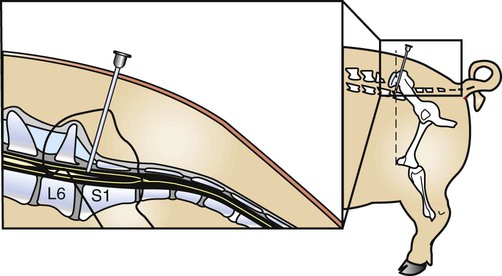After reading this chapter, you will be able to • Prepare the surgical patient for surgery • Perform local anesthesia or assist the veterinarian in administering local anesthesia • Assist or perform induction and maintenance of anesthesia • Provide anesthetic monitoring • Manage patient recovery and immediate postoperative care • Discuss the basic risks and possible complications associated with anesthesia and surgery The proper site for the epidural must be identified. The lumbosacral junction is just caudal to a line drawn transversely through the animal to connect the crests of the wings of the ilium, where the line bisects the dorsal midline. In small swine, the wings of the ilium are palpable. In large swine, anatomical landmarks must be relied upon to locate the site. Large swine are preferably injected in the standing position, standing squarely on all four legs. Looking at the pig from the side, a vertical line is drawn upward from the patella; this line usually identifies the cranial extent of the crest of the ilium. The needle is inserted 1 to Before administering anesthesia to swine, the following risks should be considered. • The larynx of swine is sensitive to physical stimulation. Pressure and touch, even from accumulated saliva, can trigger a laryngospasm. • The laryngeal lumen of the pig is small in relation to the size of the animal. A pig weighing 100 kg requires an endotracheal tube that would fit a large dog (≈14-mm internal diameter). Flexing the neck partially occludes the laryngeal entrance. Salivation, which is common in anesthetized pigs, can result in accumulations of saliva in the pharynx and laryngeal entrance that actually occlude the larynx. • Laryngeal edema results readily in swine due to their relatively fragile laryngeal mucosa. The laryngeal mucosa is quite easy to traumatize during endotracheal intubation and responds quickly with swelling. This edema of the larynx causes further narrowing of the already small lumen diameter. Various anesthetic induction and maintenance regimens are available for swine. Withdrawal times for meat-producing animals should be observed. A quiet induction area is preferred. Restraint in a chute or crate is generally less stressful than other forms of physical restraint (e.g., snout restraint). Some of the techniques in use are listed in Box 24-1.
Porcine Surgical Procedures
Swine Surgery and Anesthesia
Local Anesthesia
Lumbosacral Epidural Anesthesia
 inches caudal to this line, on dorsal midline (Fig. 24-1).
inches caudal to this line, on dorsal midline (Fig. 24-1).

General Anesthesia
Anesthetic Risks for Swine
Swine Are Prone to Hypoventilation
Airway obstruction
Preanesthetic Preparation and Anesthetic Management
Induction Drugs



